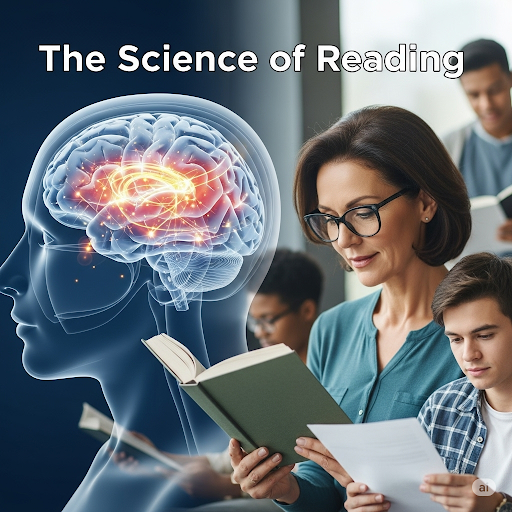
DISCOUNTED EDUCATION PRICING! CALL 1-877-891-8411. We Gladly Accept School Purchase Orders!

Reading is a transformative skill that opens doors to knowledge, creativity, and opportunity. But how do we master this complex process? Why do some struggle while others excel? The science of reading offers evidence-based answers, drawing from cognitive psychology, neuroscience, and education to unlock the secrets of literacy. In this comprehensive guide, we explore the science of reading, answer key questions, debunk myths, and provide actionable strategies for educators, parents, and learners.
The science of reading is a multidisciplinary field that explains how humans learn to read and comprehend text. It combines insights from cognitive science, linguistics, and education to identify effective teaching methods. Unlike outdated approaches, it relies on rigorous research to ensure all learners succeed.
The National Reading Panel outlines five essential components of reading instruction, known as the “Big Five”:
These components form the backbone of structured literacy, a systematic approach proven to work for all readers, including those with dyslexia.
Reading isn’t intuitive—it’s a learned skill requiring explicit instruction. Unlike spoken language, which humans naturally acquire, reading demands a rewiring of the brain. The science of reading ensures teaching methods align with how the brain processes text, benefiting both children and adults.
Question: Why do some children struggle to read despite supportive environments?
Answer: Struggles often tie to weaknesses in the Big Five. For example, poor phonemic awareness can hinder decoding, while limited vocabulary impacts comprehension. Evidence-based interventions, like those recommended by The Reading League, can address these gaps effectively.
Neuroscientists, including those at Stanford’s Center for Mind, Brain, Computation, and Technology, have mapped the brain’s “reading circuit.” Key regions include:
With practice, these areas form an efficient network, but explicit instruction is critical to activate it, especially for young learners.
Question: Can adults learn to read as effectively as children?
Answer: Yes, though it’s harder due to reduced brain plasticity. Adults benefit from targeted, intensive programs, such as those offered by Literacy How.
Phonemic awareness—identifying sounds like /k/, /æ/, /t/ in “cat”—lays the foundation for phonics, which teaches letter-sound relationships. Together, they enable readers to decode unfamiliar words.
Practical Tip: Try phonemic awareness games like segmenting words (e.g., clap for each sound in “dog”: /d/ /o/ /g/). For phonics, use decodable books from Flyleaf Publishing to reinforce patterns like “The cat sat on the mat.”
Question: Is phonics enough for reading proficiency?
Answer: Phonics is critical but must be paired with fluency, vocabulary, and comprehension for true reading success.
Fluency allows readers to process text smoothly, freeing cognitive resources for understanding. Fluent readers recognize words automatically, reading with expression and ease.
Question: How can I boost my child’s fluency?
Answer: Practice with repeated reading, audio-assisted texts, or choral reading. Resources like Epic! offer leveled books to build fluency at home.
Vocabulary fuels comprehension. The more words a reader knows, the better they understand texts. Comprehension involves connecting ideas, asking questions, and visualizing content.
Practical Tip: Build vocabulary through conversations, diverse books, and explicit word instruction. For comprehension, teach strategies like summarizing or predicting. Ask, “What might happen next?” or “Why did the character act this way?” Explore ReadWorks for free, science-of-reading-aligned passages.
Question: How can I support a struggling reader?
Answer: Create a print-rich environment, read aloud daily, and use multisensory activities like tracing letters in sand. Celebrate small wins to build confidence.
The science of reading challenges outdated beliefs:
Schools are adopting structured literacy programs aligned with the science of reading, moving away from balanced literacy’s focus on independent reading. Teacher training and early assessments are key to success.
Question: How can schools implement the science of reading?
Answer: Use evidence-based curricula, train educators, and assess students early. Resources from Amplify support this shift.
Tech tools like Lexia Learning and Newsela personalize instruction, aligning with the science of reading. They provide data to tailor teaching to individual needs.
Practical Tip: Try free tools like Starfall for phonics games or Reading A-Z for leveled texts.
Literacy gaps often affect low-income or non-English-speaking students. The science of reading promotes equitable, structured instruction to ensure all children succeed.
Question: How can we ensure equitable literacy access?
Answer: Invest in early education, train teachers in culturally responsive methods, and offer free resources like library programs or book giveaways.
Advances in neuroscience and AI are shaping literacy’s future. Brain studies, like those at Yale’s Haskins Laboratories, are refining dyslexia interventions, while AI tools personalize learning.
Call to Action: Champion the science of reading! Share this post, advocate for evidence-based curricula, and support struggling readers.
Looking for hands-on ways to apply the science of reading? Evidence-based literacy strategies can be fun and effective. Try daily phonemic awareness activities, like rhyming games or sound blending (e.g., say /c/ /a/ /t/ and ask, “What’s the word?”). For phonics, create a word wall with high-frequency words like “the” or “and” to build recognition. Boost vocabulary by introducing one new word daily, using it in a sentence or story. For comprehension, pause during read-alouds to ask, “What’s happening in the story?” These science of reading activities work for kids, English learners, and adults alike. Share your favorite literacy tips in the comments below to inspire others!
The science of reading is a revolutionary force, transforming how we unlock the power of literacy. By embracing evidence-based strategies, we can empower every reader—child or adult, struggling or advanced—to thrive in a world of words. From mastering phonemic awareness to diving into rich comprehension, each step builds confident, capable readers who can explore new ideas and shape their futures. Curious about supporting diverse learners? Check out our blog on the importance of school visuals for more insights. Take action today: grab a book, play a phonics game, or download our Science of Reading Checklist to make literacy accessible, equitable, and life-changing.